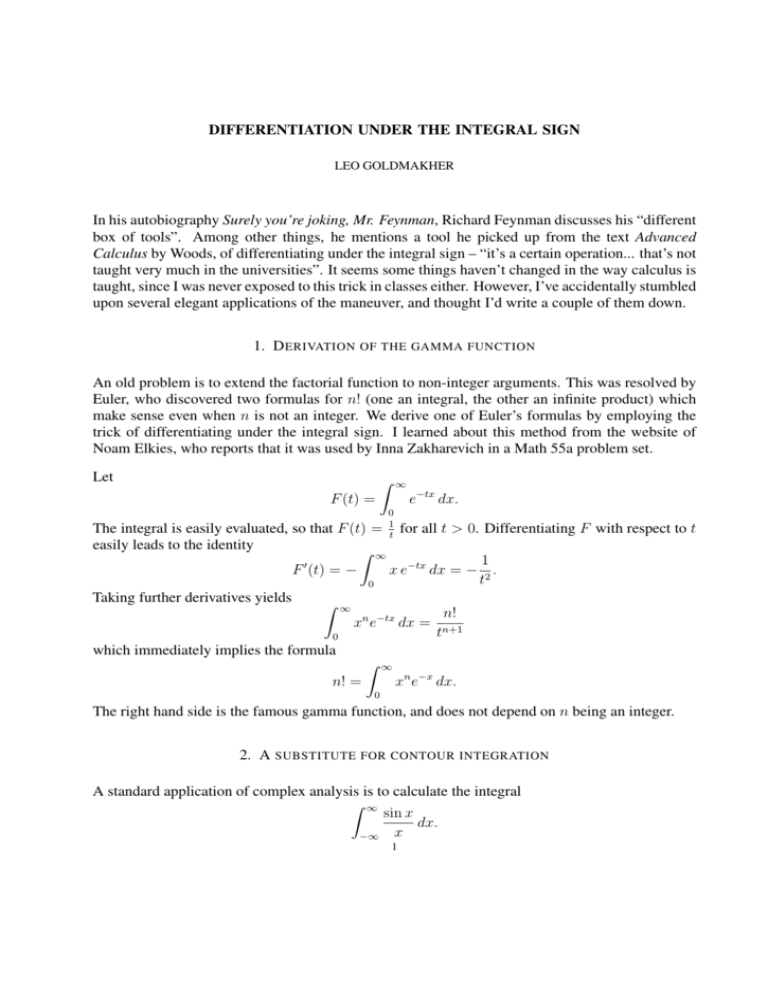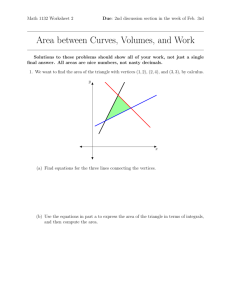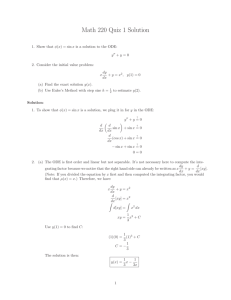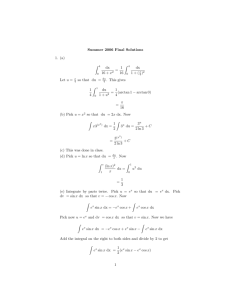Differentiating under the integral sign
advertisement

DIFFERENTIATION UNDER THE INTEGRAL SIGN LEO GOLDMAKHER In his autobiography Surely you’re joking, Mr. Feynman, Richard Feynman discusses his “different box of tools”. Among other things, he mentions a tool he picked up from the text Advanced Calculus by Woods, of differentiating under the integral sign – “it’s a certain operation... that’s not taught very much in the universities”. It seems some things haven’t changed in the way calculus is taught, since I was never exposed to this trick in classes either. However, I’ve accidentally stumbled upon several elegant applications of the maneuver, and thought I’d write a couple of them down. 1. D ERIVATION OF THE GAMMA FUNCTION An old problem is to extend the factorial function to non-integer arguments. This was resolved by Euler, who discovered two formulas for n! (one an integral, the other an infinite product) which make sense even when n is not an integer. We derive one of Euler’s formulas by employing the trick of differentiating under the integral sign. I learned about this method from the website of Noam Elkies, who reports that it was used by Inna Zakharevich in a Math 55a problem set. Let ∞ Z e−tx dx. F (t) = The integral is easily evaluated, so that F (t) = easily leads to the identity Z ∞ F 0 (t) = − 0 Taking further derivatives yields Z 0 1 t for all t > 0. Differentiating F with respect to t 1 x e−tx dx = − 2 . t ∞ xn e−tx dx = 0 n! tn+1 which immediately implies the formula Z n! = ∞ xn e−x dx. 0 The right hand side is the famous gamma function, and does not depend on n being an integer. 2. A SUBSTITUTE FOR CONTOUR INTEGRATION A standard application of complex analysis is to calculate the integral Z ∞ sin x dx. −∞ x 1 This integral is difficult to handle by standard methods, because the antiderivative of sinx x cannot be expressed in terms of elementary functions. We will calculate this integral using two tricks: differentiating under the integral sign, and representing sin x in terms of complex exponentials. First, observe that Z ∞ sin x sin x dx = 2 dx x −∞ x 0 so that it suffices to evaluate the integral on the right hand side. Set Z ∞ sin x −tx G(t) = e dx. x 0 This clearly converges for all t ≥ 0, and our aim is to evaluate G(0). We have Z ∞ 0 e−tx sin x dx. G (t) = − Z ∞ 0 This integral can be explicitly evaluated. One approach, which is elegant but somewhat ad hoc, is to integrate by parts twice. A different method, which requires more calculation but is vastly more ix −ix and integrate the result. Either way, we find that for every general, is to substitute sin x = e −e 2i t > 0, 1 G0 (t) = − . 1 + t2 It follows that G(t) = C − arctan t for some constant C. Since G(t) tends to 0 as t → ∞ while arctan t → π2 , we see that C = π2 ; in other words, π G(t) = − arctan t 2 for all t > 0. Letting t tend to 0 from the right, we conclude that G(0) = π2 . This implies that Z ∞ sin x dx = π. −∞ x 3. A CURIOUS FORMULA Let G(t) be as before. By examining G0 (t) above we found the identity Z ∞ 1 e−tx sin x dx = . 1 + t2 0 Differentiating both sides further with respect to t yields the following identity: Z ∞ dx (n − 1)! (1) xn e−tx sin x = gn (t) x (1 + t2 )n 0 where X n k gn (t) = (−1) tn−(2k+1) . 2k + 1 k≥0 ∗ i n n Observe that gn (t) = 2 (t − i) − (t + i) . ∗ I’m grateful to B. Sury for pointing this out to me. 2 Substituting this into (1) and tidying up a bit leads to the following curious result, which I have not seen before. Theorem 1. For any real number t ≥ 0 and any integer n ≥ 1 we have Z ∞ dx sin nθ xn e−tx sin x = (n − 1)! x (1 + t2 )n/2 0 1 where θ := arcsin √1+t 2. D EPARTMENT OF M ATHEMATICS , U NIVERSITY OF T ORONTO 40 S T. G EORGE S TREET, ROOM 6290 T ORONTO , M5S 2E4, C ANADA E-mail address: lgoldmak@math.toronto.edu 3






